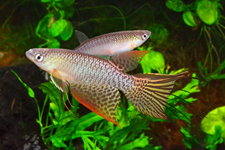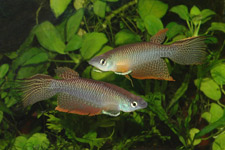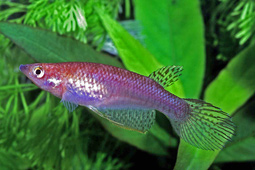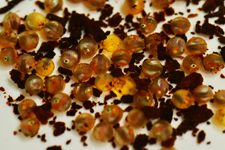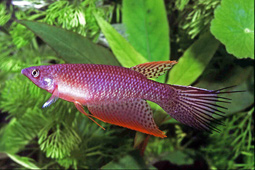History
Gnatholebias hoignei was first described by Prof. Jaimie E. Thomerson (USA) in 1974 under the name Pterolebias hoignei.
He named the species after the collector of the species named Mr. Emil Hoigne in honor of his contribution to the knowledge of New World annual Cyprinidontiform fishes.
Dr. Wilson Costa erected for this Pt. hoignei and for Pt. zonatus as well a new genus named Gnatholebias in 1998.
This move is often discussed but is for the time being accepted by other scientists.
Males of Gnatholebias hoignei show a very large Y- chromosome which is remarcable because Y- chromosomes mostly are small and large chromosomes are seldom seen in males, only in females. (Elder et al., 1991, 1993) and this now is subject to further investigation. By having a different chromosome pattern than Gnatholebias zonatus, the possibility to hybridize with Gn. zonatus that is found often syntopically is more than unlikely.
To the right a bunch of eggs of Gnatholebias hoignei just before hatching.
Reproduction
Gnatholebias hoignei can be found in the temporary pools that are not far from the rivers that are tributaries to the Orinoco River in Venezuela and as reported also in those trybutaries in Colombia.
The habitat is often in open landscape but more often in shaded pools that have muddy bottom. Because of the clay the waters are mostly turbid and the species dives into the substrate to lay their eggs. In sunny places you can see them scooling in the sun at water surface. Often they are found together with Llanolebias stellifer and with Rachovia maculipinnis and sometimes they are reported together with the other Gnatholebias member Gn. zonatus.
Breeding this species is easy but they need lots of live or frozen food to keep them in breeding condition. The species must be kept in aquaria that are not to small, about 50 liter minimum and it is wise to keep more females with one male.
As stated they dive completely into the substrate and for that they need a thick layer of peat or coco peat to dive in. To achieve the full thickness of the length of the fish it is wise to use a deep container with a covered top and an entrance opening at the side that allow the fish to enter. Diving propells the peat up and if no cover is on the top the peat will be spread into the tank leaving the container empty in a day or so. The eggs must be collected every week and stored up to 7-9 months under rather high temperatures. (28-33 C)
Be alert not to leave the peat getting to dry to much and check it so now and than for eggs that can eye- up in an earlier time.
Often sex ratio's are in favour of the males (personal comment by Dr. Bruce Turner) but in the wild often more females can be present
Variations
Map
Meristics
Max. size 11.0 cm.
Dorsal 10.7,
Anal 25.1,
D/A 17.0,
LL scale count (average)36.3
Pre- dorsal length to % SL – 74.0 %
Depth to % SL – 24.3 %
Literature
